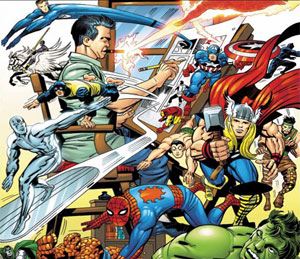Comic Problems #5 Digital or Traditional Comic Art?
By Hervé St-Louis
April 6, 2016 - 15:49
Question: Which one is better or is more valuable or legitimate for comic book art?
Answer: Both are just fine!
 |
Where do we start? Okay, let’s start with some information theory. A comic book is a document. A document is documented information. It is information recorded on a medium. When you draw a comic on a piece of paper, you record this drawing on an analog medium, usually paper. When you draw a comic using a Cintiq, a tablet and a stylus through an illustration program, you record information digitally, to some extent. Digital information is always analog, as there is a physical layer where the document is recorded on a physical medium as ones and zeroes that approximate a shape, a line, and words, through an abstraction.
Sorry about the information theory, but it helps put everything in perspective. So if comics are documents, then should the debate be about where we record them, or is it about something else? Usually it is. The debate is often about how we record them. Do we use a pencil or a stylus to record the original pages? The debate is about the skill and expertise required for an artist to record the drawing to a medium, be it paper. So then the question is really about artistry and labour?
In labour theory and political economy, how much time is spent to produce one good should not warrant the artisan or the artists more or less revenue. Revenue is assumed to be based on the baseline labour, skill, and expertise needed to produce a common good. So if it takes about 15 hours in general to produce one comic book page, it does not matter in terms of ultimate value, if the page was produced with a stylus and an animation software, or graphite paper and Conté crayons.
Now other factors will affect the revenue a cartoonist can extract from their work, regardless of whether they used digital or analogue illustration techniques. This debate, has existed in other industries since the industrial revolution. Weavers once were confronted with machines that made their labour “easier” and more productive. The new operators of the weaving machines in 19th century Britain could produce more fabric for less time and effort than those that did all the weaving with manually and foot-controlled weaving machines.
Digital comic-making often shortens the time it takes to produce a comic page. Because the mass reproduction comics involves digital printing techniques nowadays, most often, the traditional cartoonist will have to scan her work so it can be sent across the country to the editor, and then sent back to colourists, inkers, and letterers. Yes, some comics are still drawn, coloured, inked and lettered via analog ways, but their printing or distribution on the Web has to involve some form of digitization.
Cartoonists using digital techniques can easily correct errors, shift the size or flip drawing elements, save patterns and reuse them in other panels with a fraction of the effort such corrections would take in traditional techniques. When the cartoonist and the other artisans working on his comic know what they are doing, they will save time most of the time when compared to a team of creators using analogue comic-making.
Often the debate then shift to the skill and the ease of the work that digital cartoonists have access in comparison to their analogue counterparts. The claim is that somehow, because more fiddling and work around are needed to finish a page via analogue techniques, somehow that makes an artist better. I disagree.
The skill behind recording a comic as document is also about the expertise and talent needed to be an artist. Drawing digitally does not stop an artist from having done many life drawing sketches when she trained as an artist. Understanding the principles of shading, composition, and perspective can be mastered whether using a stylus or a pen. What is more beneficial for artists is that they be familiar with the different textures and tactile feel of each medium and are able to exploit the best of each.
The real complaint behind many creators against digital art is that some of it is traced and often a copy of someone else’s work. Digital illustration make copying and reproducing and recycling existing work easier. Many artists using digital tools exclusively would never be able to reproduce any of the work they do at the quality they are without the shortcuts afforded by the computer. That is the underlying criticism to much of the disdain behind digital art. But the issue of what is the extent of art should be reproduced from other sources or not deserves another column!
I’ll conclude by writing that both analogue and digital comics are valid and equal for me. I started with traditional but ten years ago, I began switching. Johnny Bullet has been almost all digitally created. Yet, I still sketch quick storyboards by hand once in while because it’s just so fast and natural. It’s not about whether analogue or digital is best. It’s about reaching my inner thoughts and posting them on paper as quickly as possible without having to start a program or stare at a screen. I’m not against using traditional techniques for Johnny Bullet at all. But I feel to that I need to have the right story to tell to use this technique. As a creator use what makes sense for you.
Related Articles:
Comic Problems #5 Digital or Traditional Comic Art?
Comic Problems #4: Quit my Day Job for Comics?
Comic Problems #3 Learn Comics in Art School?
Comic Problems #2: Redrawing Older Comics
Comic Problems #1: Copyrights versus Trademarks
